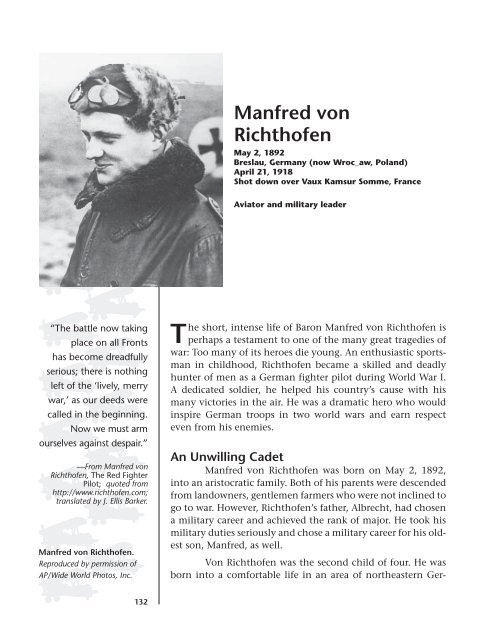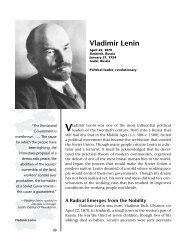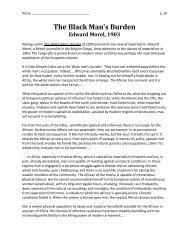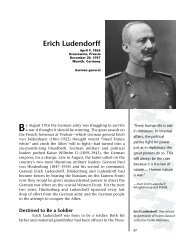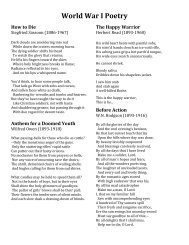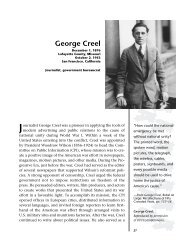Manfred von Richthofen
Manfred von Richthofen
Manfred von Richthofen
Create successful ePaper yourself
Turn your PDF publications into a flip-book with our unique Google optimized e-Paper software.
<strong>Manfred</strong> <strong>von</strong><br />
<strong>Richthofen</strong><br />
May 2, 1892<br />
Breslau, Germany (now Wroc_aw, Poland)<br />
April 21, 1918<br />
Shot down over Vaux Kamsur Somme, France<br />
Aviator and military leader<br />
“The battle now taking<br />
place on all Fronts<br />
has become dreadfully<br />
serious; there is nothing<br />
left of the ‘lively, merry<br />
war,’ as our deeds were<br />
called in the beginning.<br />
Now we must arm<br />
ourselves against despair.”<br />
—From <strong>Manfred</strong> <strong>von</strong><br />
<strong>Richthofen</strong>, The Red Fighter<br />
Pilot; quoted from<br />
http://www.richthofen.com;<br />
translated by J. Ellis Barker.<br />
<strong>Manfred</strong> <strong>von</strong> <strong>Richthofen</strong>.<br />
Reproduced by permission of<br />
AP/Wide World Photos, Inc.<br />
The short, intense life of Baron <strong>Manfred</strong> <strong>von</strong> <strong>Richthofen</strong> is<br />
perhaps a testament to one of the many great tragedies of<br />
war: Too many of its heroes die young. An enthusiastic sportsman<br />
in childhood, <strong>Richthofen</strong> became a skilled and deadly<br />
hunter of men as a German fighter pilot during World War I.<br />
A dedicated soldier, he helped his country’s cause with his<br />
many victories in the air. He was a dramatic hero who would<br />
inspire German troops in two world wars and earn respect<br />
even from his enemies.<br />
An Unwilling Cadet<br />
<strong>Manfred</strong> <strong>von</strong> <strong>Richthofen</strong> was born on May 2, 1892,<br />
into an aristocratic family. Both of his parents were descended<br />
from landowners, gentlemen farmers who were not inclined to<br />
go to war. However, <strong>Richthofen</strong>’s father, Albrecht, had chosen<br />
a military career and achieved the rank of major. He took his<br />
military duties seriously and chose a military career for his oldest<br />
son, <strong>Manfred</strong>, as well.<br />
Von <strong>Richthofen</strong> was the second child of four. He was<br />
born into a comfortable life in an area of northeastern Ger-<br />
132
many that today is part of Poland. Von <strong>Richthofen</strong> was an athletic<br />
youth who especially excelled in hunting and horseback<br />
riding. He was taught at home by tutors until he was nine years<br />
old; then he was sent to a school near his home for a year.<br />
When <strong>von</strong> <strong>Richthofen</strong> was eleven, his father sent him away to<br />
a military school in the town of Wahlstatt. Von <strong>Richthofen</strong> did<br />
not want to go, but he had to obey his father’s wishes.<br />
As a cadet in military school, <strong>von</strong> <strong>Richthofen</strong> continued<br />
to demonstrate his skill at all sports but barely scraped by in his<br />
schoolwork. He had little interest in his classes, did not get<br />
along with his schoolmates, and did only enough work to pass.<br />
Six years later, when he entered the Royal Prussian Military<br />
Academy near Berlin in 1909, <strong>von</strong> <strong>Richthofen</strong> finally began to<br />
enjoy the military life. He still triumphed at athletics, and he<br />
was starting to enjoy working and competing with his comrades.<br />
In 1911, he graduated from the academy and entered the<br />
Prussian cavalry, earning the rank of lieutenant in 1912.<br />
From Horseback to the Pilot’s Seat<br />
Von <strong>Richthofen</strong>’s lifelong love of horseback riding,<br />
along with his energy and enthusiasm, made him a natural<br />
cavalry officer. In the years before the war, his days consisted<br />
mainly of riding patrols along the Polish border and riding his<br />
own horses in races during his off-duty hours. When Germany<br />
entered World War I in August 1914, <strong>von</strong> <strong>Richthofen</strong>’s cavalry<br />
unit, the Uhlan Regiment, was called into action to aid in the<br />
German attack on Belgium and Luxembourg and to fight in<br />
the first battle of Verdun in France.<br />
It soon became apparent, however, that troops on<br />
horses were not going to hold their traditional place of importance<br />
in this modern war: Artillery was used to attack, and<br />
deep trenches were constantly being dug for defense. Von<br />
<strong>Richthofen</strong> and his men were soon off their horses and spending<br />
endless hours huddling in muddy trenches while the<br />
enemy fired shells at them. Life in the trenches was both boring<br />
and terrifying, and <strong>von</strong> <strong>Richthofen</strong> began to look for a<br />
more active way to spend the war. He sent a request to his general<br />
to be transferred to the Fliegertruppe (air service).<br />
At first <strong>von</strong> <strong>Richthofen</strong> did not plan to pilot planes<br />
because he thought that flight training would take too long.<br />
<strong>Manfred</strong> <strong>von</strong> <strong>Richthofen</strong> 133
A view of “the Flying<br />
Circus,” the squadron with<br />
which the Red Baron flew.<br />
Reproduced by permission<br />
of Hulton Getty/Archive<br />
Photos, Inc.<br />
So, in May 1915, he began his flight career as an observer, sitting<br />
beside the pilot on a bomber plane and gathering information<br />
to be used in future attacks. Soon, however, his impulsive<br />
nature won out, and he longed to take control and fly his<br />
own missions, not in the heavy bomber planes, but in the<br />
lightweight, fast, and fragile fighter planes. He persuaded a<br />
friend to teach him to fly, and after only twenty-four hours of<br />
flight training, he made his first solo flight. Though he crashed<br />
upon landing, he had learned from his years on horseback not<br />
to give up when thrown. He continued to train until 1916,<br />
when he was assigned to a fighter squadron. He made his first<br />
kill as pilot of a fighter plane on September 17, 1916.<br />
The Red Baron<br />
An able hunter on the ground, <strong>von</strong> <strong>Richthofen</strong> became<br />
a skilled hunter in the air as well. Within a few months, he had<br />
shot down ten enemy planes, the number required for a German<br />
pilot to be called an “ace.” Each day he eagerly flew up<br />
134 World War I: Biographies
into battle, honing his skills in pursuit and marksmanship.<br />
The new young ace reveled in his victories. He collected souvenirs<br />
from each plane he shot down and bought a small<br />
engraved trophy to celebrate each of his kills. His victories<br />
made him so conceited that his superior officers began to<br />
worry that he would become sloppy in his flying. However,<br />
<strong>von</strong> <strong>Richthofen</strong> never became careless, but only more and<br />
more skilled at his deadly work. His cocky attitude eventually<br />
subsided a bit as he witnessed the deaths of many of his friends<br />
and comrades.<br />
In November 1916, <strong>von</strong> <strong>Richthofen</strong> added to his fame<br />
by shooting down Major Lanoe Hawker, a famed British ace<br />
pilot. On January 16, 1917, <strong>von</strong> <strong>Richthofen</strong> was decorated<br />
with the highest German war medal, the Ordre Pour la Merite,<br />
or as it was nicknamed, the Blue Max. In the same month, he<br />
was given command of his own Jagdstaffel (fighter squadron).<br />
Jagdstaffel 11 was an unsuccessful squadron in need of a strong<br />
leader, and <strong>von</strong> <strong>Richthofen</strong> immediately began to whip them<br />
into shape. The squadron’s air victories increased dramatically,<br />
but no one had more kills than the new commander.<br />
Von <strong>Richthofen</strong> counted up his kills as enthusiastically<br />
as any sports fan keeping score. It was around this time that he<br />
painted his fighter plane bright red. He wanted it to be recognized<br />
from the ground, so that ground troops would not accidentally<br />
fire on it—and so that observers on the ground would<br />
give him credit for the planes he shot down. Other pilots in his<br />
squadron took up the practice of painting bright colors on<br />
their planes, and soon the squadron earned the fitting nickname,<br />
“the Flying Circus.” The British called the squadron<br />
commander the “red baron” or the “red knight,” and the<br />
French called him “le petit rouge” (little red). Both respected<br />
and feared the red plane’s relentless pilot was adding several<br />
kills to his record nearly every day.<br />
In April 1917, <strong>von</strong> <strong>Richthofen</strong> was promoted to captain.<br />
He was extremely valuable to the German army—not<br />
only for his combat skills, but also for his dashing and heroic<br />
image, which made an excellent propaganda (the spreading of<br />
ideas or information to further or damage a cause) tool to raise<br />
German morale. The few times he took leave to rest from the<br />
exhausting action at the front, he was pressured by those in<br />
charge of military propaganda to write the story of his adven-<br />
<strong>Manfred</strong> <strong>von</strong> <strong>Richthofen</strong> 135
From Films to Cartoons: The Red Baron Lives On<br />
For decades, World War I flying<br />
aces have captured the imagination of<br />
novelists, filmmakers, and dreamers<br />
everywhere. Perhaps it is because of the<br />
pilots’ flashy outfits, with leather helmets<br />
and coveralls, silk scarves, and fur coats;<br />
perhaps it is because of their tiny, delicate,<br />
yet fierce airplanes; perhaps it is because of<br />
their youth and their careless, smiling<br />
courage in the face of death. However, of<br />
all the daring aces, Baron <strong>Manfred</strong> <strong>von</strong><br />
<strong>Richthofen</strong>, Germany’s ace of aces, is<br />
probably the best known.<br />
In some cases, his name merely<br />
means romance. An American frozen food<br />
company uses the name Red Baron on its<br />
frozen pizza, and their commercials feature<br />
a handsome leather-helmeted pilot who<br />
turns up for dinner when his brand of<br />
pizza is cooked. In other cases, his<br />
nickname represents danger and a<br />
bloodthirsty inclination to kill: In the 1994<br />
film Revenge of the Red Baron, for example,<br />
the Baron’s ghost returns to stalk the<br />
descendants of the British pilot who killed<br />
<strong>von</strong> <strong>Richthofen</strong> in 1918.<br />
Perhaps the most famous and<br />
touching tribute to the German ace is<br />
found in Peanuts, a comic strip created in<br />
1950 by Charles Schulz (1922–2000). One<br />
of the strip’s most endearing characters is<br />
Snoopy, a philosophical beagle whose<br />
favorite game involves pretending to be a<br />
World War I flying ace on the trail of the<br />
Red Baron. “Drat you, Red Baron!” Snoopy<br />
howls, shaking his fist as the German pilot<br />
escapes again and echoing exactly the mix<br />
of frustration and grudging admiration<br />
that Allied pilots must have felt when they<br />
confronted the Red Baron in the sky.<br />
tures. He was paraded before crowds of cheering admirers, and<br />
parties were given in his honor by the leaders of the country.<br />
Though <strong>von</strong> <strong>Richthofen</strong> had sought fame and recognition, he<br />
was uncomfortable with such ceremonies; he soon wanted to<br />
leave so he could go hunting at his home in Breslau before<br />
returning to the front to shoot down enemy planes.<br />
On July 6, 1917, shortly after his fifty-seventh kill, <strong>von</strong><br />
<strong>Richthofen</strong> himself was shot down. He survived the crash of<br />
his plane behind German lines and was rescued and taken to a<br />
German military hospital with a serious gunshot wound in his<br />
head. Though he recovered enough to return to duty by<br />
August 16, it is probable that his wound never really healed.<br />
He fought the pain and continued flying, sealing his title as<br />
136 World War I: Biographies
“ace of aces” by shooting down a total of eighty enemy planes.<br />
In the winter of 1917, his memoirs, Der Rote Kampfflieger (The<br />
Red Fighter Pilot) were published. His book was distributed to<br />
German infantry soldiers to encourage them to fight bravely.<br />
On April 21, 1918, <strong>von</strong> <strong>Richthofen</strong> was in a fight<br />
against a British pilot. Pushing the limits as usual, <strong>von</strong><br />
<strong>Richthofen</strong> chased the British pilot farther and faster than the<br />
rules said he should. As a result, <strong>von</strong> <strong>Richthofen</strong>’s plane was<br />
shot down over the Somme River in France, and he was killed<br />
in the crash. He was buried with honor and given a military<br />
funeral by the British troops who recovered his body.<br />
For More Information<br />
Books<br />
Gibbons, Floyd Phillips. The Red Knight of Germany: The Story of Baron <strong>von</strong><br />
<strong>Richthofen</strong>, Germany’s Great War Bird. Garden City, NY: Doubleday,<br />
1927.<br />
Kilduff, Peter. The Illustrated Red Baron. London: Arms and Armour Press,<br />
1999.<br />
Kilduff, Peter. <strong>Richthofen</strong>: Beyond the Legacy of the Red Baron. New York:<br />
John Wiley and Sons, 1994.<br />
Wright, Nicolas. The Red Baron. New York: McGrawHill, 1977.<br />
Web sites<br />
“The Red Baron.” [Online] http://www.briggsenterprises.com/bluemax/<br />
(accessed April 2001).<br />
<strong>Richthofen</strong>, <strong>Manfred</strong> <strong>von</strong>. The Red Fighter Pilot (online text of Der Rote<br />
Kampfflieger, 1917; translated into English by J. Ellis Barker, 1918).<br />
[Online] http://www.richthofen.com (accessed April 2001).<br />
<strong>Manfred</strong> <strong>von</strong> <strong>Richthofen</strong> 137


